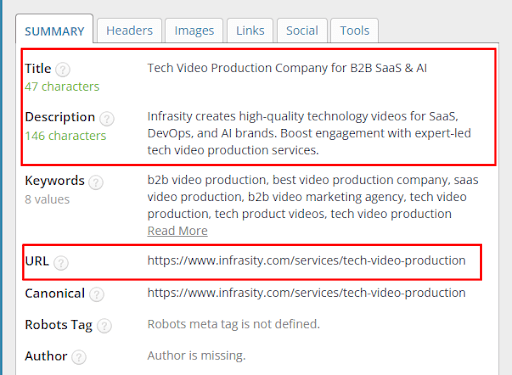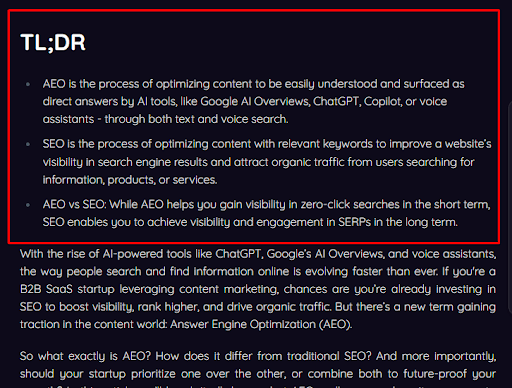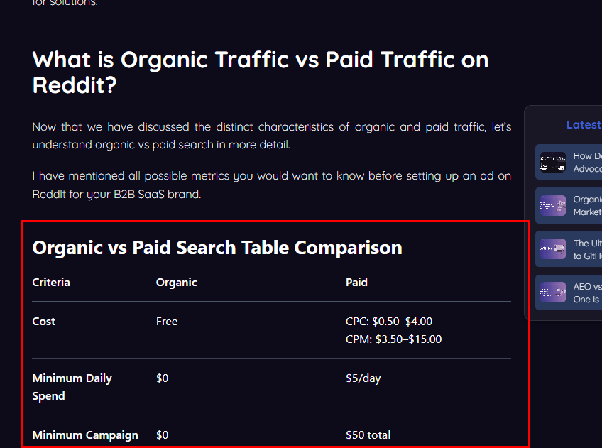TL;DR
AI now overviews and LLMs now answer queries instantly, making GEO just as important as SEO for visibility.
GEO focuses on AI trust signals, entity relevance, structured content, and citable statements drive inclusion in AI-generated answers.
TL;DR sections, keyword-rich subheadings, featured-snippet formatting, and context-rich answers boost AI discoverability.
Use schema markup, credible sources, WebP images, and quote-worthy sentences to feed AI exactly what it needs.
Fast-loading, mobile-friendly pages with clear navigation and community engagement rank higher in AI-driven search.
Everything’s changing, including search. The traditional methods will not work anymore, and backlinks and keywords aren’t enough now. AI now overviews and answers questions before users go through the traditional search process on SERP. Large language models (LLMs) have become a new layer in the discovery process, reshaping how, when, and where content is seen.
SEO helps you get found, but GEO determines what gets seen. The change is visible, but it is still early and nobody has all the answers. This allows you to compete in this early race of visibility.
So, how do you stay updated? The key is to read this blog to understand what exactly you need to do.
Why Search Changed and What Changed?
AI interfaces are changing the search game, answering complex queries instantly, often without users clicking a single link. Need to know “How do I write this API request?”? The answer now appears right where you asked, no extra tab required and most importantly, easy to understand because it is usually tailored for you.
According to SparkToro, 58.5% of all Google searches now end without a single click to a website and AI Overviews now appear in almost 47% of all searches.
Many have seen the changes. For Tally, this shift turned into a growth engine. AI-first platforms like ChatGPT and Perplexity became their top acquisition channels, fueling a leap from $2M to $3M ARR in just four months.
However, this new landscape, search isn’t just about ranking high but about showing up in entirely new spaces, under entirely new rules.
Tired of wasting engineering time on content?
Side-by-Side Comparison of GEO vs AEO Traditional SEO
Before I give you the checklist for generative engine optimization best practices, I want to make sure that your understanding of GEO Vs AEO Vs SEO is clear. If not, then take a look at the comparison table below.
| Factor | GEO | AEO | Traditional SEO |
|---|---|---|---|
| Goal | Be included in AI-generated answers | Be discoverable via voice search & assistants | Rank high on SERPs |
| Content Format | Structured, contextual, citation-worthy | Conversational, direct responses | Long-form blogs, keyword-optimized |
| Ranking Factors | Entity relevance, authority, and AI trust signals | Voice search phrasing, intent matching | Backlinks, keywords, and on-page SEO |
| User Path | Answer delivered inline | Spoken response or zero-click | Click on the website |
| See Results In | 4-12 weeks | 4-6 weeks | 3-6 months |
| Target Platforms | AI search systems (SGE, Perplexity) | Voice assistants, featured snippets | Google, Bing traditional results |
| Key Metrics | Citation frequency, inclusion in AI responses | Featured snippets, voice search appearances | Rankings, organic traffic, CTR |
| Technical Requirements | Clean HTML, semantic structure | Structured data, schema markup | Standard SEO best practices |
| User Intent Focus | Complex, multi-faceted questions | Direct questions, quick answers | Informational, commercial, navigational |
Generative Engine Optimization Best Practices You Need to Know
In 2025, Generative Engine Optimization services focus on factors AI models actually use when deciding which content to surface. I’ve noted the factors that you need to know in the field of GEO.
Entity relevance & authority: Your brand needs to be consistently associated with the topics you want to rank for.
Citable content: AI models love short, definitive statements. Don’t write long content!
Structured context: FAQs, tables, and schema markup give AI exactly what it needs.
Engagement signals: Community discussion and expert bios boost trust.
The Ultimate Checklist for GEO
Here it is, check out the checklit for generative engine optimization.
- Titles & Metadata
Create AI-ready titles that match search intent, use primary keywords naturally and don’t stuff, and stay under 60 characters. Pair them with engaging meta descriptions under 160 characters, optimized for click-through and discoverability. Keep URL slugs short, clean, and keyword-rich for better indexing and AI parsing.

Meta Title: Matches intent and is keyword-optimized. Clear, concise and ≤ 60 characters, includes primary keyword.
Meta Description: ≤ 160 characters, engaging, and keyword-rich meta descriptions.
URL Slug: Short, clean, and contains the primary keyword.
- Content Structure & Readability
Organize content for both readers and AI models with a clear TL;DR, keyword-rich subheadings, and a strong first 150 words addressing the query. Use bullets, numbered lists, and Q&A formats for featured snippets, and include real-world examples. Maintain an authoritative yet conversational tone to build trust and engagement.

TL;DR: 2–5 sentences summarizing all main points and AI pulls this easily.
Subheadings: Keyword-rich, natural, sometimes in question format for AEO
First 150 Words: Include the primary keyword & directly address the query
Structured for Featured Snippets: Use bullet points, numbered lists, and Q&A format.
Examples & Case Studies: Add real-world scenarios so that AI can quote
Authoritative Tone: Factual yet conversational for trust and engagement.
- AI-Friendly Content Practices
Write for natural discovery with well-placed keywords, entity optimization, and conversational phrasing that mirrors user prompts. Provide context-rich, standalone answers and short, quotable statements for AI citations. Strengthen credibility through relevant internal links, authoritative external sources, and trustworthy data-backed references.
Keywords: Naturally placed throughout, and definitely avoid keyword stuffing
Entity Optimization: Use related terms, synonyms, and named entities (brands, locations, concepts)
Conversational Phrasing: Mimic how users ask questions in search & AI prompts
Context-Rich Answers: Provide enough background so the answer can stand alone if AI extracts it
Quote-Worthy Sentences: Write short, definitive statements that can be cited
- Linking & Credibility
Strengthen authority with 3–4 relevant internal links to related content and external references only from reputable, high-authority sources. Back claims with credible data and statistics, ensuring every fact is verifiable. This builds trust with both human readers and AI systems, increasing your chances of being cited.
Internal Links: 3-4 relevant internal blog/page links
External Links: Only to reputable, high-authority sources
Data & Stats: Always link to credible references (boosts AI trust signals)
Visuals & Structured Data
Support AI understanding with schema markup like FAQPage, HowTo, and Article formats. Use fast-loading WebP images with descriptive alt text, concise infographics, and data tables to enhance clarity. These elements not only improve human readability but also increase AI parsing accuracy.

- Schema Markup: Use FAQPage, HowTo, and Article schema to help AI parse content.
Images: WebP format for fast loading
Alt Text: Descriptive, keyword-informed for accessibility & AI context
Infographics: Summarize data or bullet-heavy sections
Tables: Include at least one before the conclusion
User Experience & Technical
Ensure your site loads in under 2.5 seconds, is mobile-responsive, and has intuitive navigation. Avoid thin content—aim for 800–1,200+ words for depth. Build trust with clear author bios (E-E-A-T), encourage comments for community signals, and share insights designed for social and AI-driven amplification.
Fast Load Speed: Under 2.5 seconds because AI prefers well-optimized sites
Mobile-Friendly: Fully mobile responsive
Clear Navigation: Logical menu and breadcrumb structure
No Thin Content: Minimum 800–1,200 words for depth unless it's a short-answer FAQ
Engagement & Community Signals
Boost credibility by showcasing an author bio that demonstrates E-E-A-T,your experience, expertise, authority, and trustworthiness. Encourage interaction through comments and discussions to signal active community engagement. Share insights that are easily quotable on social media and attractive for AI-generated summaries to widen reach.
Author Bio: Establish E-E-A-T (Experience, Expertise, Authoritativeness, Trustworthiness) in the content.
Comments & Discussion: Enabling comments and discussion shows community engagement
Shareable Insights: Create content worth quoting on social media & AI-generated summaries
Every devtool startup needs content. Most do it wrong.
Final Thought
The Generative Engine Optimization best practices aren’t just a buzzword anymore. It’s the new battleground for visibility. Traditional SEO still matters, but it’s no longer enough when AI-powered search platforms decide what gets seen.
By aligning your content with AI trust signals, structuring it for zero-click answers, and optimizing for entity relevance, you position your brand to be part of the conversation, literally and figuratively. The sooner you adapt to these intelligent organic GEO checklists, the better your chances of leading in this early, high-reward phase of discovery.
So, does your content pass all the checkpoints?
Frequently Asked Questions
- What is Generative Engine Optimization (GEO)?
Generative Engine Optimization is the process of optimizing your content so that AI models similar to those powering ChatGPT, Google’s AI Overviews, or Perplexity surface it in their generated responses. Unlike traditional SEO, GEO focuses on entity authority, structured context, and citable statements rather than just backlinks and keywords. - How is GEO different from traditional SEO?
While SEO targets rankings in search engine results pages (SERPs), GEO is about being featured in AI-generated answers. That means optimizing for AI trust signals, schema markup, entity relevance, and concise, quote-worthy content that AI can easily reference. - Why is GEO important in 2025?
With AI interfaces answering queries directly, often without a single click, GEO ensures your brand is still visible. Companies adopting generative engine optimization services early are already seeing faster inclusion in AI responses and improved brand authority. - What are the top GEO ranking factors for 2025?
The biggest factors include entity relevance and authority, structured context (like FAQs and tables), high-quality outbound and inbound links, citable statements, and technical optimization like fast page speed and mobile responsiveness. - How do I get started with GEO?
Start by following intelligent organic SEO checklists designed for AI search, incorporating schema markup, creating concise yet authoritative content, and partnering with a generative engine optimization agency that understands both traditional and AI-first discovery.



